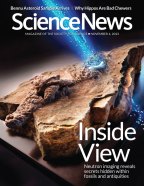Readers react to neutron imaging and the expanding definition of loneliness
- More than 2 years ago

A peek inside
Neutron tomography can help scientists capture 3-D images of the insides of fossils and artifacts without damaging them. The technique can uncover hidden features within dense material that X-ray scanning can’t detect, James R. Riordon reported in “Seeing into the past” (SN: 11/4/23, p. 18).
Reader Rob Janes asked how the 3-D images are captured.
In neutron tomography, scientists blast beams of neutrons at an object they want to study, Riordon says. Detectors on the other side of the object record the proportion of neutrons that make it through without being reflected or absorbed along the way. Using that data, computer algorithms create virtual slices of the object, which can then be assembled to provide 3-D views of the object’s interior, he says.
Reader Heidi Wilson asked whether neutron tomography has been used on ancient manuscripts that can’t be unfolded.
X-ray computed tomography has been the go-to method for analyzing ancient manuscripts, Riordon says. The artifacts are generally made of low-density material, such as papyrus or parchment, that X-rays can effectively image.
One recent exception, reported in 2021 in Archaeometry, is a medieval amulet made of a folded lead scroll that contains inscriptions. Since X-rays cannot easily penetrate particularly dense materials like lead, the researchers turned to neutron tomography to virtually unfold the sheet and reveal the inscribed runes. “Although ancient metal manuscripts are comparatively rare, neutrons offer a way to read them without risking the damage that opening them up would cause,” Riordon says.
Thinking about loneliness
Social scientists are learning more about how feeling detached from animals, places and routines — not just people — can cause loneliness. These revelations may lead to new interventions, Sujata Gupta reported in “What is loneliness?” (SN: 11/4/23, p. 24).
“While reading [this story], I found myself once again thinking about the demise of the front porch in our communities…. Having grown up in a small town in western New York that came into its own in the mid-1800s, front porches are to be found on most of the older homes,” reader Jim Sobek wrote. “A few years ago, while in town for a week of bicycling, I spent an evening with cousins on their front porch. As we whiled away the evening in conversation, neighbors out for their evening walks stopped by to talk for a while and then went on their way, only to be replaced by other neighbors also taking their evening constitutionals. Warm greetings and friendly conversation were exchanged between neighbors who knew each other well.”
Many modern homes “have large backyards, large decks, some pools and always-spacious air-conditioned interiors, but at best only a small covered concrete front stoop,” Sobek continued. “The residents often do not speak with neighbors, and sometimes don’t even know who their neighbors are.” While these homes are more comfortable, Sobek wonders whether they have also contributed to the loneliness and loss of community that some people now feel.
Correction
In “Clear the air,” the unit of the x-axis in the graph titled “Methane emissions in 2022, by source” was labeled incorrectly (SN: 11/18/23, p. 18). It should have been million metric tons, not metric tons.